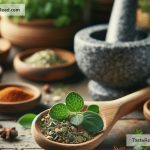How to Incorporate Wildcrafted Plants for Sustainable Flavors
In the world full of packaged and processed foods, many of us are seeking ways to connect back to nature and discover more authentic, sustainable food sources. One incredible journey to embark on is learning how to use wildcrafted plants in our daily meals. Wildcrafting is the practice of harvesting plants from their natural, or ‘wild’ habitat, for food, medicinal purposes, or as ingredients in cooking. It’s a beautiful way to enhance your dishes with unique, sustainable flavors while respecting and preserving our natural environment. Today, we’re going to explore some simple strategies to get started with incorporating wildcrafted plants into your culinary adventures.
Start Small and Be Safe
Before you dive into foraging and picking any plant you find attractive, it’s crucial to start small and prioritize safety. Always ensure you can positively identify any wild plant before consuming it, as some plants can be harmful or even toxic. Invest in a good field guide specific to your area or consider joining a local foraging group where you can learn from experienced foragers.
Know the Seasons
Just like cultivated fruits and vegetables, wild plants have their seasons too. Some plants may only be available in the spring, while others might thrive in the late summer or fall. Learning about the seasons will not only help you plan your foraging activities but also ensures that you get the best flavors and nutritional benefits from the plants you harvest.
Sustainable Harvesting Practices
One of the foundational principles of wildcrafting is to harvest in a way that does not harm the plant population or the ecosystem. Always follow the rule of taking only what you need and leave enough behind so the plant can continue to grow and reproduce. For instance, if you’re harvesting leaves, never take all the leaves from a single plant. Similarly, when picking berries or fruits, leave enough for wildlife and other foragers.
Tasty Wildcrafted Plants to Get You Started
Several wild plants are not only safe to eat but also provide incredible flavors and nutritional benefits. Here are a few you might start with:
- Dandelion: Every part of this common ‘weed’ is edible. The leaves can be added to salads or sautéed as greens, and the flowers make a lovely wine or jelly.
- Wild Garlic: Found in woodlands in the spring, wild garlic (or ramps) leaves are delicious in pesto, salads, and as a flavoring in soups and stews.
- Nettles: Rich in vitamins, nettles must be cooked to remove their sting but afterwards can be used much like spinach.
- Blackberries: Wild blackberries can be found in many hedgerows and woods during the late summer. They are perfect for desserts, jams, or eaten fresh.
Using Wildcrafted Plants in Cooking
Now that you’ve foraged some wild ingredients, it’s time to get cooking. Here are a few ideas to inspire you:
- Infusions and Teas: Many wild herbs and flowers can be dried and used to create delicious teas or infused into oils and vinegars.
- Soups and Stews: Wild greens, mushrooms, and roots can add unique flavors and nutrition to soups and stews.
- Baking: Wild fruits and berries are fantastic in pies, cakes, and other baked goods.
- Salads: Fresh wild greens and flowers can transform an ordinary salad into a vibrant, flavorful dish.
Conclusion
Incorporating wildcrafted plants into your cooking is not just about adding new and exciting flavors to your dishes; it’s also a journey back to nature, a way to connect with the environment, and a step towards a more sustainable lifestyle. As we learn to forage responsibly and appreciate the bounty nature offers, we also contribute to preserving these resources for generations to come. So, put on your walking shoes, grab a basket, and let the adventure begin! Remember to start small, prioritize safety, and always harvest sustainably. Happy foraging!

